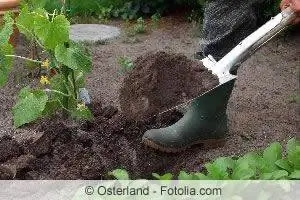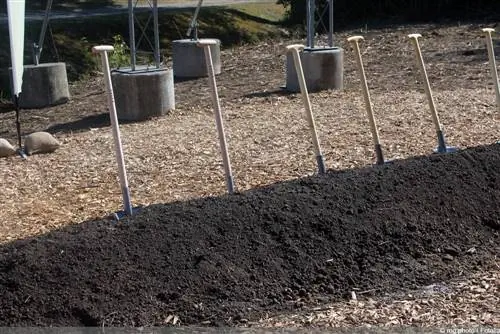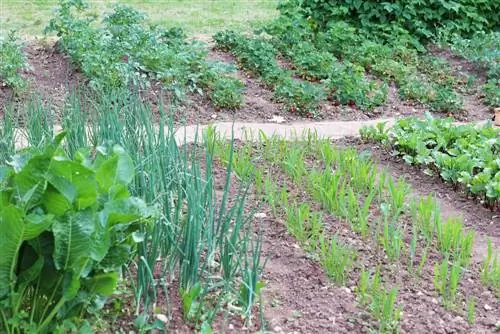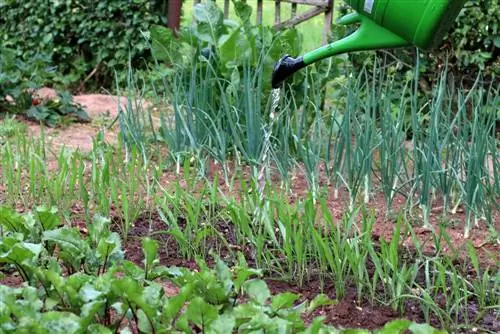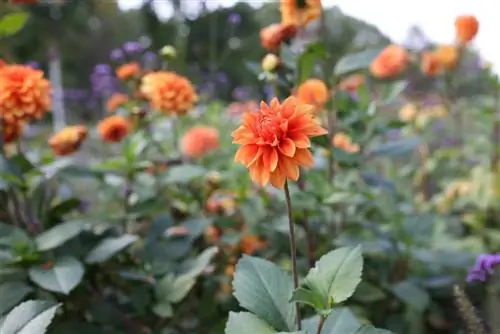- Author admin [email protected].
- Public 2023-12-17 03:39.
- Last modified 2025-06-01 06:48.
If you want to create a vegetable patch in your garden, you have to work out a good concept in advance so that your project will be successful for years to come. Different types of vegetables require different amounts of nutrients. In addition, deficiency symptoms or diseases often occur with monocultures or constant planting. That's why it's important to know in which combination and order the different vegetables should be grown in the vegetable patch.
Good planning is a basic requirement
If you plan to create a vegetable patch in your garden, you should start planning in the fall to winter of the previous year. Future cultivation areas can already be prepared now. Choose an area in the garden that is easily accessible and meets the necessary site conditions. In addition, the bed can be dug up in the fall, the soil improved and possibly stable manure or compost incorporated as a source of nutrients. Newbies should start small and slowly work their way into the vegetable concept. Work that can be done in advance:
- Fertilization
- Soil improvement
- Planning the planting sequence and mixed culture
- Get seeds
- The pre-growing of the plants on the windowsill begins in February
Tip:
A vegetable bed should not exceed a width of 1.30 meters, as this ensures that the area is easily accessible from all sides. If in doubt, it is better to create several small beds rather than one large one.
Location
Almost all vegetables prefer a sunny to partially shaded location in the garden. Some species also tolerate midday sun well. Overall, however, a bed that provides shade for a few hours a day would be optimal.
- sunny to partially shaded
- at least five to six hours of sun per day
- A windbreak may be necessary in drafty areas
Create the best conditions
Two things are particularly important so that the vegetables grow really well:
- a good soil
- high quality seeds
- alternatively pre-grown plants from the nursery
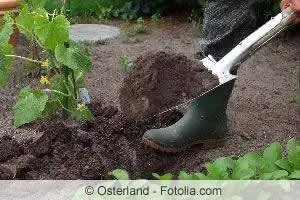
Floor
Well-drained, humus-rich garden soil is particularly suitable for a vegetable patch. If the soil is not optimal, it must be prepared accordingly before cultivation. If you are not sure about the quality of your garden soil, you can order a soil analysis for just a few euros (sets available in garden centers or pharmacies).
- Fertilize soil with compost in autumn
- possibly incorporate sand
- dig up again in spring and loosen the soil
- Removing stones, roots and weeds
Which vegetables to grow and when?
Once the cultivation area has been determined and possibly already prepared, the actual, creative gardening begins. The selection of vegetable plants depends on one's own taste, so a gardener should consider which types of vegetables he actually wants to grow. The plants are then divided into two groups:
- Vegetables with a long growing time (main crop): such as potatoes, cabbage, cucumbers and carrots
- Vegetables with a short growing period (pre- and post-culture): such as spinach or bush beans
So that the bed can be used to the best possible extent, each main crop is now combined with a pre- and/or post-crop to form a specific crop rotation. It is important to ensure that not only the cultivation times match, but that the plants also “get along” with each other. Not all types of vegetables can be grown one after the other or together in the bed.
Tip:
In order not to miss the time of sowing, planting and harvesting, the dates should be noted in the calendar early on.
Cold frame and raised bed
Covered beds or even a raised bed have proven to be ideal for growing lettuce and vegetable plants that are sensitive to cold. Here, temperatures are already higher in early spring, when the rest of the ground in the garden may still be frozen, which prevents frost damage. Ideal for giving the plants a good head start over the outdoor plants and for being able to harvest early.
Mixed culture - what goes together?
In addition to the correct location conditions and soil properties, the compatibility of the individual types of vegetables must also be taken into account when planting a vegetable bed. A distinction is made here:
- neutral plants: Can be easily combined with other plants
- promoting plants: certain combinations have a positive effect
- inhibiting plants: combinations that hinder each other's growth
If you want to create a vegetable patch correctly, you should check in advance what fits together and what doesn't. Here are some combinations that go well together and benefit each other:
- Carrots with chard, garlic, peas, radishes, tomatoes, salsify, onions
- Potatoes with bush beans, kohlrabi, horseradish, caraway
- Cauliflower with celery, peas and French beans
- Zucchini with onions, runner beans and basil
- Cucumbers with fennel, cabbage, beetroot, lettuce, peas
Crop rotation
Crop rotation plays another crucial role in growing vegetables. Crop rotation refers to the order in which vegetable plants are grown one after the other in the same bed. Not only can the nutrients in the soil be optimally utilized, but diseases can also be avoided. If a vegetable patch is laid out correctly, it will contain high levels of nutrients in the first spring. That's why it makes sense to first grow vegetables that are highly depleting, meaning they remove large amounts of nutrients from the soil. The three-year crop rotation has proven successful:
- First year: Grow predominantly heavy-feeding vegetable plants
- Second year: plant medium-intensive vegetables
- Third year: Cultivate medium to low-yielding vegetable plants
In the fall of the third year, the bed is completely harvested and fertilized again with compost. The compost can then rot well over the winter. This means that the vegetable bed is optimally prepared for planting in spring. Now we start again with the heavy eaters.
Which vegetables cannot be grown one after the other?
Plants that belong to the same plant family must not be planted on the same bed the following year. Two plant families are particularly affected here:
- Chenopodiaceae: chard, beetroot, spinach
- Cruciferous vegetables (Brassiacaceae): radishes and radishes, all types of cabbage, turnips (such as turnips)
If this rule is not followed, persistent infestations with pests can occur, such as clubroot.
Four-field farming or four-year crop rotation
If you have a little more space in your garden, you should divide your bed into four areas or create four different beds. In four-field farming, the crop rotation model is applied to each of the four beds, each time shifted by one year. While a bed has a high nutrient content and is planted with high-nutritional plants, there is also a bed with medium-nutritious plants and one that is cultivated with low-nutritive vegetables. The fourth bed lies fallow for a year or is subjected to green manure to regenerate.
- Beet 1 Green manure: Growth conditions for later crops are optimized. Green manure also suppresses weeds and protects against soil erosion.
- Bed 2: first year of the three-year crop rotation (heavy feeders)
- Bed 3: second year of the three-year crop rotation (medium feeder)
- Bed 4: third year of the three-year crop rotation (weak feeders)
The switch to weaker consuming plants takes place annually. After the nutrients are used up, green manure is planted in the fourth year.
Which vegetables are heavy eaters?
The following varieties require particularly high nutrient contents in the soil. That's why they are planted on the vegetable bed in the year after green manure or after fertilization with compost, for example:
- cabbage
- Potatoes
- Carrots
Medium-nutritive vegetables
In the second year, vegetables that require medium nutrient content are in demand. These include:
- Peas
- Beans
- Cucumbers
- Fennel
- Leek
- Radish
- Tomatoes
- Peppers
- Kohlrabi
- Onions
Low-consuming vegetables
In the third year there are only low nutrient levels in the soil. In order to make optimal use of this, the following plants are recommended:
- Salad
- Herbs
- cress
Tip:
Tomatoes, rhubarb, strawberries and asparagus can be grown in the same location for many years.
Examples of two beds with alternating planting
Bed 1
- 1. Year: Cauliflower and Broccoli
- 2. Year: Strawberries
- 3. Year: Strawberries
Beet 2
- 1. Year: Kohlrabi and Savoy cabbage
- 2. Year: Chinese cabbage and endive
- 3. Year: annual herbs
Beet 3
- 1. Year: Potatoes
- 2. Year: Celery and Tomatoes
- 3. Year: Lettuce and Peas
Conclusion
Creating a vegetable patch correctly is sometimes not that easy for beginners. It's best to start small and only cultivate a small area, which you plant over three years with various vegetable plants using crop rotation and mixed culture. It is best to create a precise three-year plan right from the start, which should be strictly adhered to during this time. More experienced gardeners can then include an additional pre- or post-crop in the second year.

